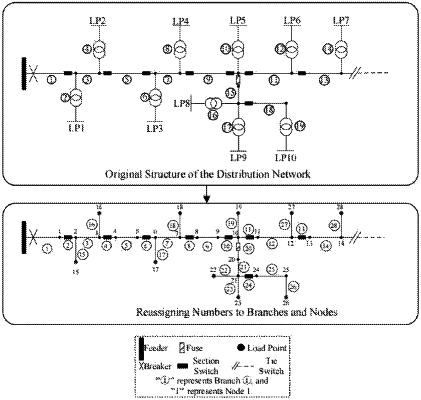| CPC G05B 23/0283 (2013.01) [G05B 19/042 (2013.01); G06F 30/13 (2020.01); H02J 3/00 (2013.01)] | 6 Claims |

|
1. A reliability evaluation method of a power distribution network, wherein the reliability evaluation method is executed by a processor of a device for analyzing and calculating reliability indexes of the power distribution network, and the reliability evaluation method comprises steps of:
(A1) acquiring parameters of the power distribution network, wherein the parameters are network topology connection relationship, failure rate, failure repair time, switch operation time and node load demand;
(A2) building a reliability calculation model, which comprises treating the power distribution network as a node-branch calculation unit, and numbering nodes and branches in the power distribution network, wherein:
the reliability calculation model is a node-branch association model, section switches and fuses are regarded as special branches, two ends of each of branches are respectively connected with two load nodes, the each of branches is provided between every two adjacent load nodes; if there is no load node at one end of one of the branches, a load node where both the number of users and node load demand are zero is added;
(A3) building correlation matrices, and calculating a power supply path matrix and a tie-line matrix, wherein the correlation matrices are a node-branch association matrix, a section switch matrix and a fuse matrix;
(A4) deriving a fault incidence matrix IF through the power supply path matrix, the section switch matrix, the fuse matrix and the tie-line matrix, and calculating the reliability indexes of the power distribution network, wherein:
a matrix on a main diagonal of the fault incidence matrix IF is obtained through relationship between characteristic formulas and fault influence types in a table as follows:
| ||||||||||||||||||||||||||||||||||||||
here, “x” indicates an impossible characteristic formula;
there are four influence types of a branch fault on the load node, the four influence types are type-a, type-b, type-c and type-d respectively; type-a means that all power supply paths of a load are disconnected when the branch fault occurs, and the load is restored to be supplied only after the branch fault is repaired; type-b means that all power supply paths of the load are disconnected when the branch fault occurs, and the load is restored to be supplied by a main power supply after the branch fault is isolated; type-c means that all power supply paths of the load are disconnected when the branch fault occurs, the load is restored to be supplied by a standby power supply; and type-d means that the branch fault has no effect on the load node; and
(A5) identifying vulnerable links which affect reliability of the power distribution network by performing sensitivity analysis through partial derivative transformation for quantifiable parameters or perturbation transformation for unquantifiable parameters on an expression of the reliability indexes, thereby avoiding repetitive calculation of the reliability indexes and achieving reliability evaluation of the power distribution network.
|
||||||||||||||||||||||||||||||||||||||